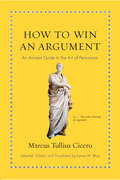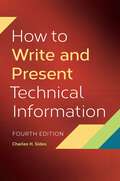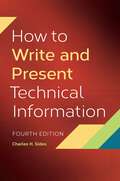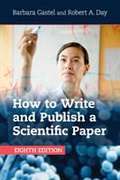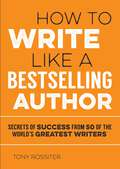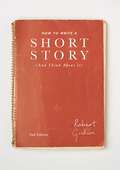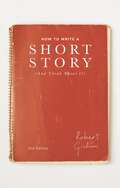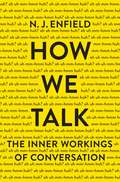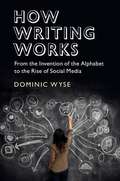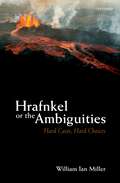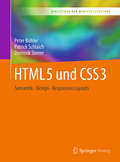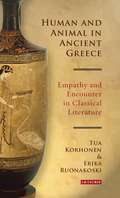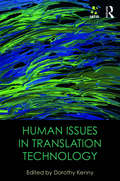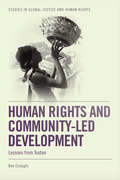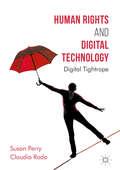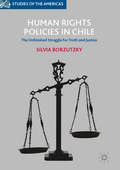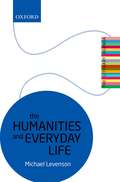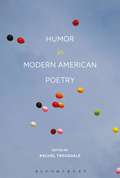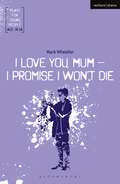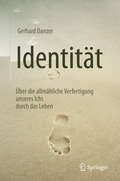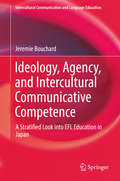- Table View
- List View
How to Win an Argument: An Ancient Guide to the Art of Persuasion
by Marcus Tullius Cicero James M. MayAll of us are faced countless times with the challenge of persuading others, whether we're trying to win a trivial argument with a friend or convince our coworkers about an important decision. Instead of relying on untrained instinct—and often floundering or failing as a result—we’d win more arguments if we learned the timeless art of verbal persuasion, rhetoric. How to Win an Argument gathers the rhetorical wisdom of Cicero, ancient Rome’s greatest orator, from across his works and combines it with passages from his legal and political speeches to show his powerful techniques in action. The result is an enlightening and entertaining practical introduction to the secrets of persuasive speaking and writing—including strategies that are just as effective in today’s offices, schools, courts, and political debates as they were in the Roman forum.How to Win an Argument addresses proof based on rational argumentation, character, and emotion; the parts of a speech; the plain, middle, and grand styles; how to persuade no matter what audience or circumstances you face; and more. Cicero’s words are presented in lively translations, with illuminating introductions; the book also features a brief biography of Cicero, a glossary, suggestions for further reading, and an appendix of the original Latin texts.Astonishingly relevant, this unique anthology of Cicero’s rhetorical and oratorical wisdom will be enjoyed by anyone who ever needs to win arguments and influence people—in other words, all of us.
How to Write and Present Technical Information
by Charles H. SidesThoroughly updated to discuss the use of tools such as Skype and social media, this concise volume shows how effective communication—via written text and spoken presentations—can positively impact project management in professional environments.Professional communications are the "information product" of all organizations and businesses. Based on that premise, this book offers communications strategies that will benefit any organization that disseminates technical information in-house and/or to customers. The popular work provides easy-to-understand and apply guidelines for designing and writing effective technical documents, as well as other related communications. What makes this new edition especially valuable is that it maintains the quality of information that distinguished the previous editions, but is now updated to encompass current technology and trends, including today's prevalent communication tools such as social media.The book begins by looking at skills common to all technical writing and offering general advice on designing and writing reports. Next is a discussion of specific types of reports along with common problems and issues writers face. Finally, the work overviews other forms of communications such as professional presentations. The updated material also considers the growing importance of interviews and focus groups as information-gathering tools, the influence of visual rhetoric, and the use of technologies such as Skype and webinars.
How to Write and Present Technical Information
by Charles H. SidesThoroughly updated to discuss the use of tools such as Skype and social media, this concise volume shows how effective communication—via written text and spoken presentations—can positively impact project management in professional environments.Professional communications are the "information product" of all organizations and businesses. Based on that premise, this book offers communications strategies that will benefit any organization that disseminates technical information in-house and/or to customers. The popular work provides easy-to-understand and apply guidelines for designing and writing effective technical documents, as well as other related communications. What makes this new edition especially valuable is that it maintains the quality of information that distinguished the previous editions, but is now updated to encompass current technology and trends, including today's prevalent communication tools such as social media.The book begins by looking at skills common to all technical writing and offering general advice on designing and writing reports. Next is a discussion of specific types of reports along with common problems and issues writers face. Finally, the work overviews other forms of communications such as professional presentations. The updated material also considers the growing importance of interviews and focus groups as information-gathering tools, the influence of visual rhetoric, and the use of technologies such as Skype and webinars.
How to Write and Publish a Scientific Paper (Eighth Edition) (PDF)
by Robert Day Barbara GastelAn essential guide for succeeding in today's competitive environment, this book provides beginning scientists and experienced researchers with practical advice on writing about their work and getting published. This brand new, updated edition also includes a new chapter on editing one's own work, a section on publicizing and archiving one's paper, and updates on authorship, including information on new authorship criteria and on the author identification number ORCID. The book guides readers through the processes involved in writing for and publishing in scientific journals, from choosing a suitable journal, to writing each part of the paper, to submitting the paper and responding to peer review, through checking the proofs. It covers ethical issues in scientific publishing, explains rights and permissions, and discusses writing grant proposals, giving presentations and writing for general audiences.
How To Write A Great Story (Engage Literacy Purple - Extension A)
by Kelly GaffneyDo you like to read great stories? Would you like to write one? Learn all about writing a great story.
How to Write Like a Bestselling Author: Secrets of Success from 50 of the World's Greatest Writers
by Tony RossiterIlluminating the best-known works of 50 celebrated authors, writing coach Tony Rossiter shows you how they achieved their phenomenal success. He explains how each author began writing, and examines their style, techniques and routine for creative insights. If you want to write a bestseller, this guide will set you on the path to success.
How to Write A Short Story (And Think About It)
by Robert GrahamShort story publishing is flourishing in the twenty-first century and is no longer seen as a poor relation of the novel. But what is a short story? And how do you write one? Robert Graham takes you through everything you need to know, from how a writer works to crafting and editing your own fiction. This heavily revised edition features new chapters by contemporary fiction writers. Stressing the importance of reading broadly and deeply, the book includes a wide range of prompts and writing exercises. It teaches you how to read as a writer and write like somebody who has read. You will learn the elements of craft you need to produce short stories, and one of the key writer’s disciplines: reflecting on your own work. Whether you are a student or an experienced author, this book will teach you how to write short stories – and reflect on the creative processes involved. The book features chapters from writer-teachers James Friel, Rodge Glass, Ursula Hurley, Heather Leach, Helen Newall, Jenny Newman, James Rice and Tom Vowler.
How to Write A Short Story (And Think About It)
by Robert GrahamShort story publishing is flourishing in the 21st century and is no longer seen as a poor relation of the novel. But what is a short story? And how do you write one? Robert Graham takes you through everything you need to know, from how a writer works to crafting and editing your own fiction.This heavily revised edition features new chapters by contemporary fiction writers. Stressing the importance of reading broadly and deeply, the book includes a wide range of prompts and writing exercises. It teaches you how to read as a writer and write like somebody who has read. You will learn the elements of craft you need to produce short stories, and one of the key writer's disciplines: reflecting on your own work. Whether you are a student or an experienced author, this book will teach you how to write short stories – and reflect on the creative processes involved. The book features chapters from writer-teachers James Friel, Rodge Glass, Ursula Hurley, Heather Leach, Helen Newall, Jenny Newman, James Rice and Tom Vowler.
How We Talk: The Inner Workings of Conversation
by N. J. EnfieldAn expert guide to how conversation works, from how we know when to speak to why huh is a universal wordWe all had teachers who scolded us over the use of um, uh-huh, oh, like, and mm-hmm. But as linguist N. J. Enfield reveals in How We Talk, these "bad words" are fundamental to language.Whether we are speaking with the clerk at the store, our boss, or our spouse, language is dependent on things as commonplace as a rising tone of voice, an apparently meaningless word, or a glance--signals so small that we hardly pay them any conscious attention. Nevertheless, they are the essence of how we speak. From the traffic signals of speech to the importance of um, How We Talk revolutionizes our understanding of conversation. In the process, Enfield reveals what makes language universally--and uniquely--human.
How Writing Works: From the Invention of the Alphabet to the Rise of Social Media (PDF)
by Dominic WyseFrom the invention of the alphabet to the explosion of the internet, Dominic Wyse takes us on a unique journey into the process of writing. Starting with seven extraordinary examples that serve as a backdrop to the themes explored, it pays particular attention to key developments in the history of language, including Aristotle's grammar through socio-cultural multimodality, to pragmatist philosophy of communication. Analogies with music are used as a comparator throughout the book, yielding radically new insights into composition processes. The book presents the first comprehensive analysis of the Paris Review Interviews with the world's greatest writers such as Louise Erdrich, Gabriel Garcia Mrquez, Ted Hughes, and Marilynne Robinson. It critically reviews the most influential guides to styles and standards of language, and presents new research on young people's creativity and writing. Drawing on over twenty years of findings, Wyse presents research-informed innovative practices to demonstrate powerfully how writing can be learned and taught.
Hrafnkel or the Ambiguities: Hard Cases, Hard Choices
by William Ian MillerWilliam Ian Miller presents a close reading of one of the best known of the Icelandic sagas, showing its moral, political, and psychological sophistication. Hrafnkel tells of a fairly simple feud in which a man rises, falls, and rises again with a vengeance, so to speak. The saga deals with complex issues with finely layered irony: who can one justifiably hit, when, and by what means? It does this with cool nuance, also taking on matters of torture and pain-infliction as a means of generating fellow-feeling. How does one measure pain and humiliation so as to get even, to get back to equal? People are forced to set prices on things we tell ourselves soporifically are priceless, such as esteem, dignity, life itself. Morality no less than legal remedy involves price-setting. This book flies in the face of all the previous critical literature which, with very few exceptions, imposes simplistic readings on the saga. A translation of the saga is provided as an appendix.
HTML5 und CSS3: Semantik - Design - Responsive Layouts (Bibliothek der Mediengestaltung)
by Peter Bühler Patrick Schlaich Dominik SinnerDieser Band der „Bibliothek der Mediengestaltung“ bietet eine kompakte Einführung in die Webstandards HTML5 und CSS3 als Basis zur Erstellung multimedialer und responsiver Webseiten.Für diese Bibliothek wurden die Themen des Kompendiums der Mediengestaltung neu strukturiert, vollständig überarbeitet und in ein handliches Format gebracht. Leitlinien waren hierbei die Anpassung an die Entwicklungen in der Werbe- und Medienbranche sowie die Berücksichtigung der aktuellen Rahmenpläne und Studienordnungen sowie Prüfungsanforderungen der Ausbildungs- und Studiengänge.Die Bände der „Bibliothek der Mediengestaltung“ enthalten zahlreiche praxisorientierte Aufgaben mit Musterlösungen und eignen sich als Lehr- und Arbeitsbücher an Schulen sowie Hochschulen und zum Selbststudium.
Human and Animal in Ancient Greece: Empathy and Encounter in Classical Literature (Library of Classical Studies)
by Tua Korhonen Erika RuonakoskiAnimals were omnipresent in the everyday life and the visual arts of classical Greece. In literature, too, they had significant functions.This book discusses the role of animals - both domestic and wild - and mythological hybrid creatures in ancient Greek literature. Challenging the traditional view of the Greek anthropocentrism, the authors provide a nuanced interpretation of the classical relationship to animals. Through a close textual analysis, they highlight the emergence of the perspective of animals in Greek literature. Central to the book's enquiry is the question of empathy: investigating the ways in which ancient Greek authors invited their readers to empathise with non-human counterparts. The book presents case studies on the animal similes in the Iliad, the addresses to animals and nature in Sophocles' Philoctetes, the human-bird hybrids in The Birds by Aristophanes and the animal protagonists of Anyte's epigrams. Throughout, the authors develop an innovative methodology that combines philological and historical analysis with a philosophy of embodiment, or phenomenology of the body. Shedding new light on how animals were regarded in ancient Greek society, the book will be of interest to classicists, historians, philosophers, literary scholars and all those studying empathy and the human-animal relationship.
Human Issues in Translation Technology: The IATIS Yearbook (The IATIS Yearbook)
by Dorothy KennyTranslation technologies are moulded by and impact upon humans in all sorts of ways. This state-of-the-art volume looks at translation technologies from the point of view of the human users – as trainee, professional or volunteer translators, or as end users of translations produced by machines. Covering technologies from machine translation to online collaborative platforms, and practices from ‘traditional’ translation to crowdsourced translation and subtitling, this volume takes a critical stance, questioning both utopian and dystopian visions of translation technology. In eight chapters, the authors propose ideas on how technologies can better serve translators and end users of translations. The first four chapters explore how translators – in various contexts and with widely differing profiles – use and feel about translation technologies as they currently stand, while the second four chapters focus on the future: on anticipating needs, identifying emerging possibilities, and defining interventions that can help to shape translation practice and research. Drawing on a range of theories from cognitive to social and psychological, and with empirical evidence of what the technologization of the workplace means to translators, Human Issues in Translation Technology is key reading for all those involved in translation and technology, translation theory and translation research methods.
Human Issues in Translation Technology: The IATIS Yearbook (The IATIS Yearbook)
by Dorothy KennyTranslation technologies are moulded by and impact upon humans in all sorts of ways. This state-of-the-art volume looks at translation technologies from the point of view of the human users – as trainee, professional or volunteer translators, or as end users of translations produced by machines. Covering technologies from machine translation to online collaborative platforms, and practices from ‘traditional’ translation to crowdsourced translation and subtitling, this volume takes a critical stance, questioning both utopian and dystopian visions of translation technology. In eight chapters, the authors propose ideas on how technologies can better serve translators and end users of translations. The first four chapters explore how translators – in various contexts and with widely differing profiles – use and feel about translation technologies as they currently stand, while the second four chapters focus on the future: on anticipating needs, identifying emerging possibilities, and defining interventions that can help to shape translation practice and research. Drawing on a range of theories from cognitive to social and psychological, and with empirical evidence of what the technologization of the workplace means to translators, Human Issues in Translation Technology is key reading for all those involved in translation and technology, translation theory and translation research methods.
Human Rights and Community-led Development: Lessons from Tostan (Studies In Global Justice And Human Rights Ser.)
by Ben CislaghiProvides cross-disciplinary perspectives on the study of animals in humanities
Human Rights and Digital Technology: Digital Tightrope
by Claudia Roda Susan PerryAnalysing the convergence of law and regulation with rapidly evolving communications technologies, this interdisciplinary work navigates the intricate balancing act between human rights protection and technological innovation in a digital age, and illuminates the comprehensive potential of human rights to frame our intelligent use of technology. The authors address such pressing questions as how to protect user privacy online, whether digital pollution is a health hazard, who should have control and be responsible for data technologies and how to maintain human autonomy in a world of interconnected objects. By considering specific cases, this book provides an in-depth exploration of the many regulatory and technological choices citizens, states, civil society organizations and the private sector should consider to ensure that digital technology more fully serves human needs.
Human Rights Policies in Chile: The Unfinished Struggle for Truth and Justice
by Silvia BorzutzkyThis book analyses Chile’s “truth and justice” policies implemented between 1990 and 2013. The book’s central assumption is that human rights policies are a form of public policy and consequently they are the product of compromises among different political actors. Because of their political nature, these incomplete “truth and justice” policies instead of satisfying the victims’ demands and providing a mechanism for closure and reconciliation generate new demands and new policies and actions. However, these new policies and actions are partially satisfactory to those pursuing justice and the truth and unacceptable to those trying to protect the impunity structure built by General Pinochet and his supporters. Thus, while the 40th anniversary of the violent military coup that brought General Pinochet to power serves as a milestone with which to end this policy analysis, Chile’s human rights historical drama is unfinished and likely to generate new demands for truth and justice policies.
Human Rights Policies in Chile: The Unfinished Struggle for Truth and Justice
by Silvia BorzutzkyThis book analyses Chile’s “truth and justice” policies implemented between 1990 and 2013. The book’s central assumption is that human rights policies are a form of public policy and consequently they are the product of compromises among different political actors. Because of their political nature, these incomplete “truth and justice” policies instead of satisfying the victims’ demands and providing a mechanism for closure and reconciliation generate new demands and new policies and actions. However, these new policies and actions are partially satisfactory to those pursuing justice and the truth and unacceptable to those trying to protect the impunity structure built by General Pinochet and his supporters. Thus, while the 40th anniversary of the violent military coup that brought General Pinochet to power serves as a milestone with which to end this policy analysis, Chile’s human rights historical drama is unfinished and likely to generate new demands for truth and justice policies.
The Humanities and Everyday Life: The Literary Agenda (The Literary Agenda)
by Michael LevensonThe Literary Agenda is a series of short polemical monographs about the importance of literature and of reading in the wider world and about the state of literary education inside schools and universities. The category of 'the literary' has always been contentious. What is clear, however, is how increasingly it is dismissed or is unrecognised as a way of thinking or an arena for thought. It is sceptically challenged from within, for example, by the sometimes rival claims of cultural history, contextualized explanation, or media studies. It is shaken from without by even greater pressures: by economic exigency and the severe social attitudes that can follow from it; by technological change that may leave the traditional forms of serious human communication looking merely antiquated. For just these reasons this is the right time for renewal, to start reinvigorated work into the meaning and value of literary reading. We think of the humanities as a cluster of specialized academic activities. So they are. But they also belong to the ordinary world, the world where students and faculty make connections and careers; where they eat and drink and fret; where they move through new buildings and old seminar rooms. In The Humanities and Everyday Life Michael Levenson places academic humanities within this field of daily life, where abstract thought stands alongside material need. The humanities also live outside the university in activities that have been overlooked or undervalued: in book clubs, in historical re-enactments, in visits to museums and libraries, in private collections, in contributions to Wikipedia, and in amateur genealogy. These activities belong to the humanities, quite as much as research published in specialty journals. The Humanities and Everyday Life addresses both the university and the world beyond, to see where they meet and fail to meet, and to argue that the walls between them should lower. At the centre of the book is an account of experts and expertise, a controversial topic that poses questions about professionals versus amateurs and what constitutes expertise. Drawing on the recent rejection of political elite expertise, as seen in the Brexit referendum and the American election campaign, as well as examples from science and medicine, the volume reveals the unsteady boundary between specialized knowledge and public curiosity. The Humanities and Everyday Life asks us to accept that the humanities are as enduring as religion, are indeed both rival and complement to religion; and to acknowledge that despite imperfections, they give an image of many-dimensioned life. The humanities are worth improving on their own terms, but also because, just often enough, they constitute an exemplary micro-society, one that will illuminate still more widely when academic thought meets the light of the everyday.
Humor in Modern American Poetry
by Rachel TrousdaleModern poetry, at least according to the current consensus, is difficult and often depressing. But as Humor in Modern American Poetry shows, modern poetry is full of humorous moments, from comic verse published in popular magazines to the absurd juxtapositions of The Cantos. The essays in this collection show that humor is as essential to the serious work of William Carlos Williams as it is to the light verse of Phyllis McGinley. For the writers in this volume, the point of humor is not to provide “comic relief,” a brief counterpoint to the poem's more serious themes; humor is central to the poems' projects. These poets use humor to claim their own poetic authority; to re-define literary tradition; to show what audience they are writing for; to make political attacks; and, perhaps most surprisingly, to promote sympathy among their readers. The essays in this book include single-author studies, discussions of literary circles, and theories of form. Taken together, they help to begin a new conversation about modernist poetry, one that treats its lighthearted moments not as decorative but as substantive. Humor defines groups and marks social boundaries, but it also leads us to transgress those boundaries; it forges ties between the writer and the reader, blurs the line between public and private, and becomes a spur to self-awareness.
Humor in Modern American Poetry
by Rachel TrousdaleModern poetry, at least according to the current consensus, is difficult and often depressing. But as Humor in Modern American Poetry shows, modern poetry is full of humorous moments, from comic verse published in popular magazines to the absurd juxtapositions of The Cantos. The essays in this collection show that humor is as essential to the serious work of William Carlos Williams as it is to the light verse of Phyllis McGinley. For the writers in this volume, the point of humor is not to provide “comic relief,” a brief counterpoint to the poem's more serious themes; humor is central to the poems' projects. These poets use humor to claim their own poetic authority; to re-define literary tradition; to show what audience they are writing for; to make political attacks; and, perhaps most surprisingly, to promote sympathy among their readers. The essays in this book include single-author studies, discussions of literary circles, and theories of form. Taken together, they help to begin a new conversation about modernist poetry, one that treats its lighthearted moments not as decorative but as substantive. Humor defines groups and marks social boundaries, but it also leads us to transgress those boundaries; it forges ties between the writer and the reader, blurs the line between public and private, and becomes a spur to self-awareness.
I Love You, Mum - I Promise I Won't Die (Plays for Young People)
by Mark WheellerI'd had a conversation specifically with Dan about ecstasy. It's one of the things you do as a parent, isn't it? Wear your helmet when you're out on your bike, you know, don't take drugs. To be honest, I was more worried about him being safe on his bike than at a party with his friends.The words of the title are the last ones spoken by sixteen-year-old Daniel Spargo-Mabbs to his mother. One evening in January 2014, Daniel's parents thought he was going to a friend's house. He actually attended an illegal rave and later died after taking MDMA. That fateful evening is told through the words of his school friends and family, divided into two hard-hitting acts in Mark Wheeller's verbatim play.I Love You, Mum - I Promise I Won't Die was commissioned by the charity set up in Daniel's memory to raise awareness about the danger of party drugs. It is a fast-paced, tragic, vibrant piece of verbatim theatre, which should engage teenage readers, audiences and performers alike.
Identität: Über die allmähliche Verfertigung unseres Ichs durch das Leben
by Gerhard DanzerDas Thema Identität ist wahrscheinlich so alt wie die Menschheit, und die Frage nach dem Wer oder Was unserer Existenz hat wohl die Menschen schon vor Jahrtausenden bewegt.Ausgehend von den vielen Spielarten der Identitätssuche verfolgt dieses Buch die diversen Identitäts- und Lebensmuster; daraus erfolgt eine kritische Reflexion des Begriffs der Identität und die Frage, inwiefern wir überhaupt von uns als einem identischen, sich stets gleichbleibenden Wesen sprechen können. es werden philosophische und psychologische Beiträge zur Identitätssuche vorgestellt und verschiedene kulturelle Richtungen und Strategien wie Aufklärung, Bildung, Erziehung, Tiefenpsychologie dazu befragt.Im letzten Teil des Buchs werden einige literarische Beiträge zur Identitätssuche erörtert - anhand von bekannten Werken wird gezeigt, wie Gestalten energisch um ihre Identität ringen und an dieser Aufgabe (beinahe) scheitern.
Ideology, Agency, and Intercultural Communicative Competence: A Stratified Look into EFL Education in Japan (Intercultural Communication and Language Education)
by Jeremie BouchardAssociated with an important epistemological shift from language proficiency to language criticality in applied linguistic research, this book provides a sociological perspective on foreign language education in Japan. By employing ethnographic methods to investigate the relationship between three core analytical elements – foreign language education geared towards the development of learners’ intercultural communicative competence; nihonjinron and native-speakerism as potentially constraining ideological forces; and EFL practices observed at four Japanese junior high schools – the author not only shares valuable insights into how English is taught and learned in a stratum of the Japanese EFL system which has received limited attention from researchers over the years, but also clarifies the fundamental and complex changes currently taking place in the Japanese EFL landscape. This multi-faceted book also calls for greater consideration in postmodern ideology critique for the stratified nature of social processes as well as the material conditions and underlying generative mechanisms involved in the production and consumption of (including resistance to) ideological discourse. Accordingly, it outlines several challenges shaping ideology research in educational settings, and responds by developing a realist-oriented theoretical and methodological approach to address these challenges. This book serves as a unique point of reference for the study of parallel nationalist discourses embedded in foreign language education systems around the world.
